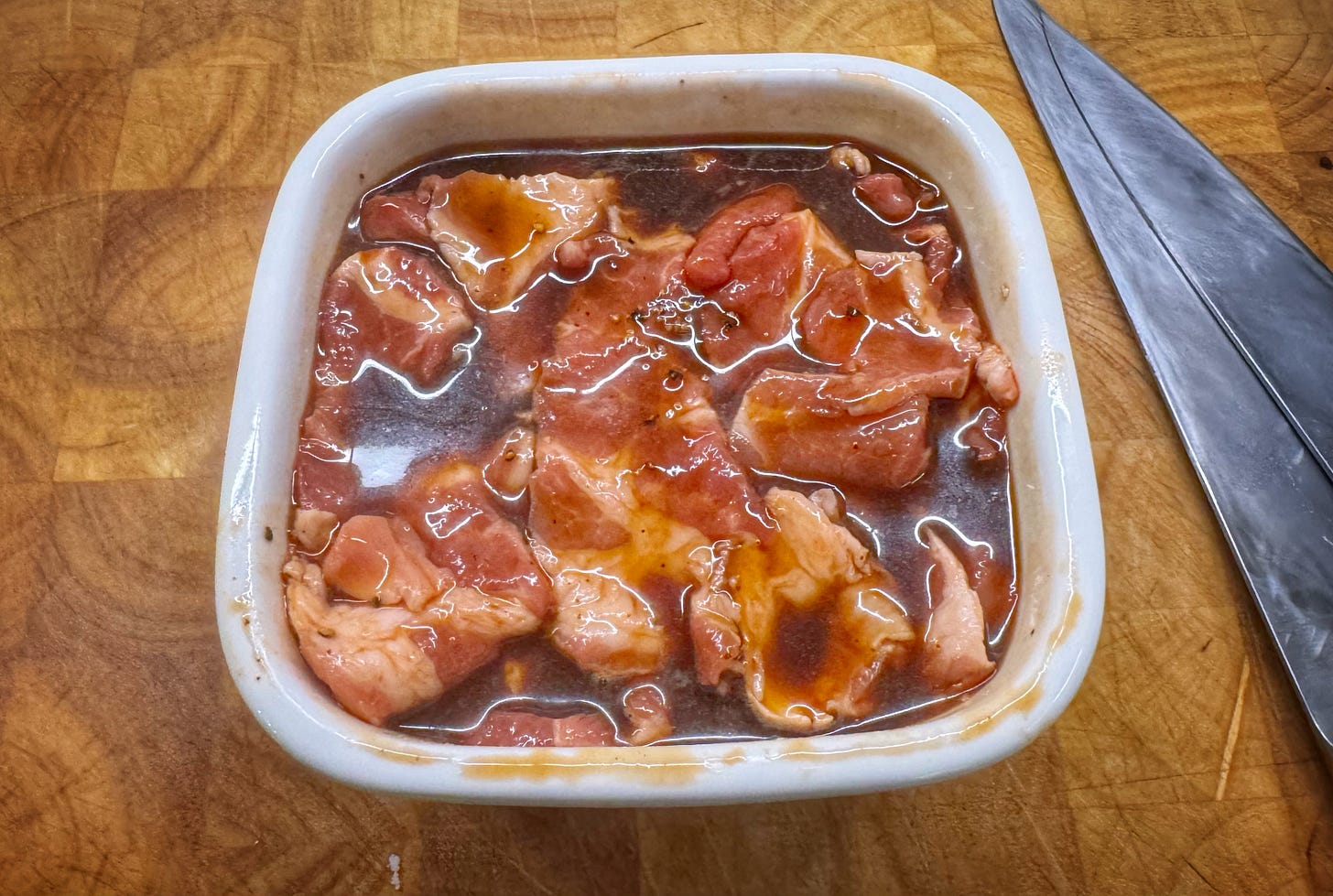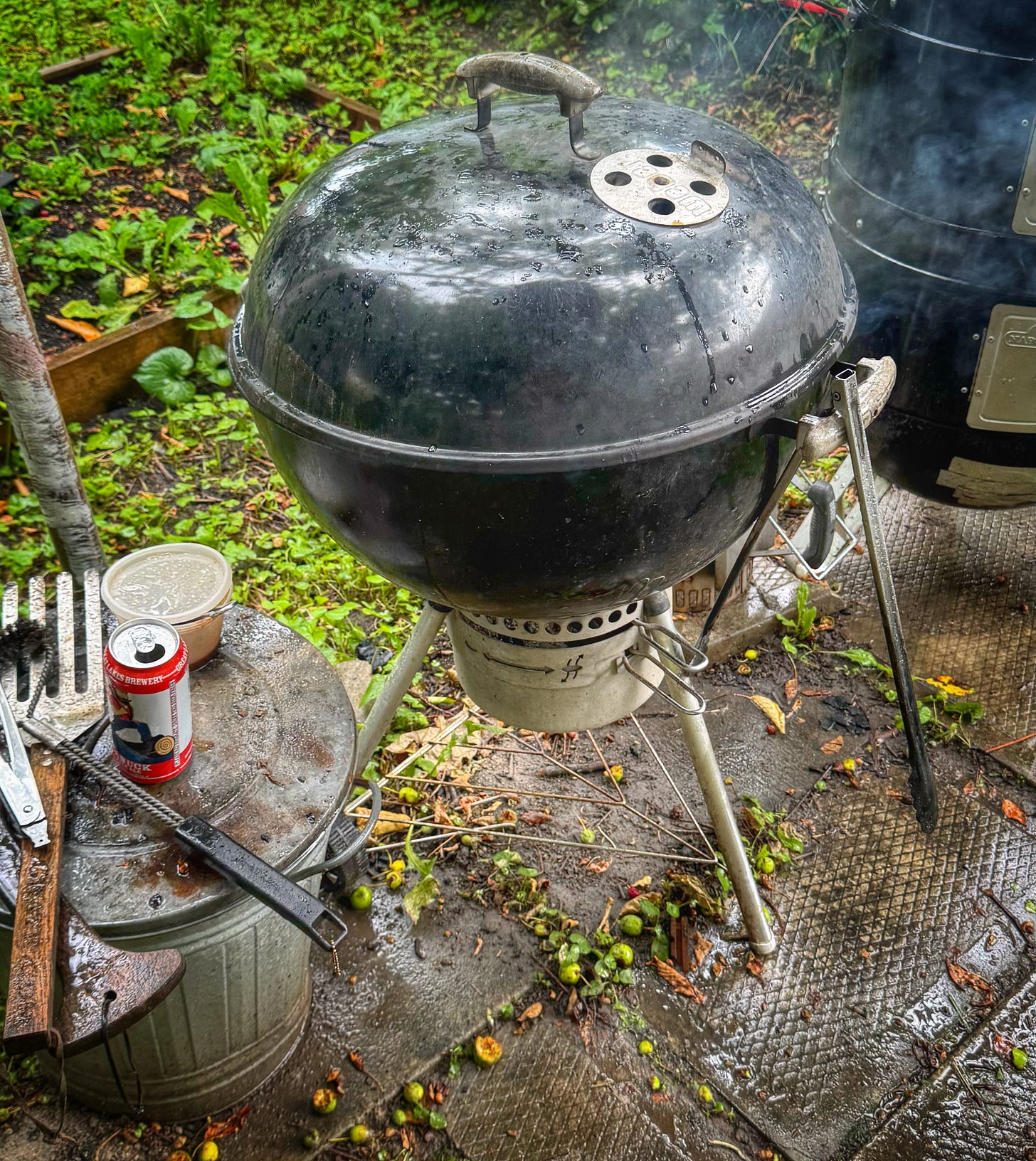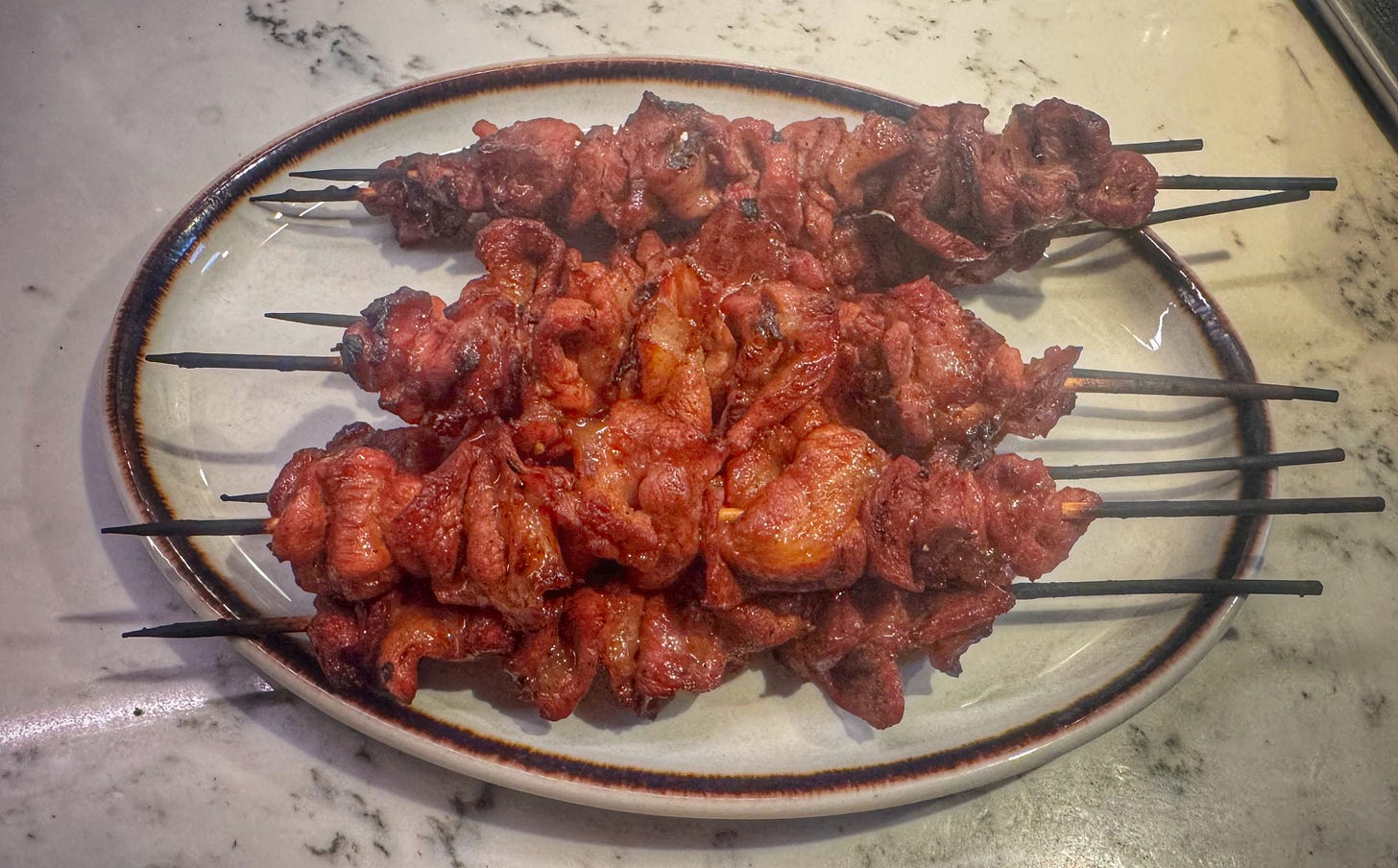65. Sticking it to Myself
When you're wrong, you're wrong.
When writing about food, disingenuousness1 is always a short and easy leap away. I realized this while writing my first and only restaurant review, about a restaurant that no longer exists for a publication that no longer exists.2 It was impossible for anyone to challenge what I wrote about the food because I was the only one who had eaten it. I could, if I chose, write almost anything.
This happens with some frequency, such as when food writers don’t disclose conflicts of interest3 or their personal agendas. Or just making things seem rosier than they could ever possibly be. Then there’s lying about how long it takes to caramelize onions. This happens in all kinds of writing, I guess, but there is something about the personal and immediate interaction we have with food that makes it even easier to fudge or occlude the truth. We all see the same film and hear the same piece of music, and can point to particular passages from either in a review, but a bite of food is gone forever. It’s something I’ve always kept in mind.
One of the only rules4 I have about writing The Plate Cleaner is that I have to be as honest as possible.5 No one who cooks (or writes) is perfect all of the time, which I have done my best to show time and again. (For instance, here. Here. Here. Here. And here.)
All of which is to say: I done messed up.
When I wrote my last Plate (as my newsletter consiglieri Chris Frey and I refer to this enterprise), in addition to the skewers I cooked myself, I also mentioned souvlaki, shish kebab, suya, anticuchos, kofta, and Xinjian lamb skewers. Somehow, I left out one of the greatest skewers of all.
But first, let’s back up a bit.
Our niece was visiting on the weekend and we figured the night market at Harbourfront would be a fun outing. Upon arriving, we took the obligatory lap around the booths to get a sense of what we wanted to try. After some pretty good tteokbokki6 and a tasty pile of mini pancakes cooked in a pan similar to one you’d use to cook takoyaki or aebleskiver, topped with strawberries and bananas, we were on the hunt for our next score.
When we got to the stand for Wilson’s Haus of Lechon, a highly pork-centric restaurant in Toronto’s Little Manila, we put the order in our niece’s hands. She was born in the Philippines and her mother is a killer cook, so I figured that not only would she be a great judge of what was available, but that she might also get a slightly larger serving as a nod to her shared Pinoy heritage.7
She chose a BBQ pork skewer so there was no quantity bump to be had. No matter; we still had grilled, skewered pork in a sweet, tangy sauce to enjoy. It was fantastic and just as I remembered it when we took her to the Taste of Manila festival a few years ago. I immediately started kicking myself for overlooking it when putting together the last Plate. It is a top-tier8 skewer.

I had screwed up and I knew I had to make amends. The piece of pork shoulder I had in the fridge, which was supposed to become the Red Chile Brochettes I made previously, would instead become Filipino BBQ Pork Skewers.9 Fortunately, YouTube and the rest of the Internet are rife with recipes for them and, happily, almost all of them seem to be posted by Filipinos and not other folks “simplifying” or “elevating” them.
Just like many skewers, these required some time to marinate before being threaded onto sticks and grilled. There were some variations from recipe to recipe, but they all had the same basic marinade ingredients: soy sauce,10 sugar, garlic (in one form or another), citrus juice (calamansi if available, lemon if not), Sprite or 7Up, and banana ketchup (often labeled as “banana sauce”).
I had seen banana ketchup before, but I’d never bought it or tried it on its own.11 Our neice’s description, “It tastes like ketchup but it also doesn’t,” was very accurate. It has the sweet, tart, savoury, and fruity flavours of tomato ketchup, but there’s something different going on as well. There’s no overt banana flavour—if you were given a sample blindly, you’d never guess it was made with them—but it’s lurking subtly in the background.
Let’s back up a bit further.
The flavour of banana ketchup, it turns out, is not the most interesting thing about it. Unlike most foods, definitive credit for the invention of banana ketchup can be given to one person: Maria Ylagan Orosa. She moved from Manila to the US in 1916 and earned her bachelor’s and master’s degrees in pharmaceutical chemistry and her bachelor’s degree in food chemistry from the University of Washington in Seattle.
Despite being offered a job with the State of Washington, Orosa chose to return home. A committed nationalist—her father fought for the resistance movement against Spain and the United States—Orosa wanted to help the Philippines become more food self-sufficient and less reliant on foreign products.
Reducing reliance on foreign imports and resisting American hegemony? This was someone I could relate to!12 This was an unexpected twist from when I started writing a post I had conceived as being about how “I’m a dumbass and I forgot about one of the best skewered foods of all time.”
Upon her return to the Philippines, Orosa went to work for the Bureau of Sciences, tackling problems like malnutrition and food insecurity. From her school summer vacations spent working in salmon canneries in Alaska, she introduced the processes of canning and preserving, which weren’t yet widely adopted in the Philippines, and used them to preserve local products to extend their utility. And when there was a shortage of imported tomatoes, she invented banana ketchup, which has since become a staple in Filipino kitchens.
Her story doesn’t end there. When Japan invaded the Philippines in 1941, Orosa, like her father before her, joined the resistance. She invented Soylac, a nutrient-rich drink made from soy beans and rice flour that could be baked into cookies13 to sustain resistance fighters and, through the system she established for smuggling them into internment camps, 4,000 civilian detainees, most of whom were American. Sadly, she was wounded during the battle for Manila and then died when the hospital she had been taken to was struck by American shelling.
You can read more about Maria Ylagan Orosa in Lady Science’s excellent account of her life and the New York Times’ barely-better-late-than-never obituary, both of which I have stolen from extensively. It’s a remarkable story that I might never have learned about if our niece hadn’t ordered what she did. Is there anything food can’t do?
Back to the present
Once the marinade was mixed together, I poured it over the thinly sliced pork shoulder and left it in the fridge overnight. The next day I soaked some skewers in water while the charcoal was starting and then threaded the pork slices onto them. Then I made another batch of the marinade as a basting sauce, this time leaving out the Sprite.
Unfortunately, it was pouring with rain when I wanted to start grilling. I’m crafty enough to get charcoal started when it’s raining, but whenever I removed the grill’s lid to turn or baste the skewers, they got pelted with raindrops. I’m going to blame this for my skewers not developing the thick, glossy glaze or charred edges that Wilson’s Haus of Lechon did. As soon as I would brush some sauce on, the rain would sploosh it off.
Served with some jasmine rice, as well as zucchini and asparagus I cooked inside after deciding I could no longer stand the rain, the skewers were a decent approximation of what we’d had at the night market. I’m now motivated to try other recipes and see if I can get mine as close as I can to Wilson’s benchmark sticks.
What I’m consuming… I gave you two articles about Maria Ylagan Orosa! What more do you vultures want? How about an article about another use for bananas: banana vinegar. It’s relatively easy to make and a use for old bananas that doesn’t leave you with another unwanted loaf of banana bread. I can no longer find the page about making banana vinegar that listed the basic steps as: 1) hang a bunch of bananas on a string 2) put a bucket under the bananas to catch what drips as they rot 3) that’s vinegar! This recipe seems much more thorough and less likely to attract pests of all sizes.
What’s on the menu… Cole Slaw. As I write this, we are about to leave for a Canada Day barbecue at some friends’ house. When I asked what we could bring, the answer (jokingly) was, “Your best side dish.” I don’t know if cole slaw is absolutely my best side dish, but it is one that I can make very well without consulting a recipe. Shredded cabbage and carrot tossed with salt and sugar to draw out some moisture, then rinsed, dried, and dressed with mayo, sour cream, buttermilk, onion and garlic powder, cider vinegar, Dijon mustard, Old Bay, Worcestershire sauce, MSG, Lizano Salsa,14 salt and pepper. Easy! Maybe I should do a video on my slaw non-recipe?
Disingenuity?
If you’re a really die hard reader, you can find the first three paragraphs of it here. If you reply to this email with the secret code word “OnlyReview” I will copy and paste the rest of the review and send it to you.
The post on Bon Appétit announcing the new restaurants list initially did not even include the editor’s note mentioning what’s a pretty clear conflict of interest.
The others are: “Whenever possible, no links to sites that enrich billionaires,” and “Never go in against a Sicilian when death is on the line.”
As far as you know!
These required the standard street foot posture of bending forward at the waist so as not to drip any of the brick red, gochugaru-ful tteokbokki sauce onto our clothes. It was a near-universal stance at the market because every stand seemed to be selling at least one drippy item.
When it happens to me, I jokingly call it “The Asian Bump.” If I go alone to the hot table at Ample, I definitely get served more than if Beth is with me. There is probably also “The Italian Bump” and “The Portuguese Bump” but, of course, I haven’t experienced them.
Or, as a Filipino friend called them when I DMed him a photo of the ingredients, “Sweet sweet diabetes on a stick!”
I bought Filipino soy sauce for this, which became the 14th type of soy sauce in the pantry.
As well as being an ingredient in BBQ marinade, it’s also a key component in the sweet spaghetti sauce at Jollibee.
Please note: I’m in no way equating what I’m doing with the absolutely incredible work Orosa did, but I certainly feel where she’s coming from.
This brings to mind manba, the traditional Haitian peanut butter that has been fortified and adapted to fight childhood malnutrition as well as support local peanut farmers. The original, non-therapeutic version is usually spicy and really good. A Canadian-made version is available here.
Also, somewhere deep in The Plate Cleaner archives there is a sketch of an issue about manba, Haiti, the USDA and USAID, and, eventually, the evils of globalized capitalism. It’s not quite on brand, but reading through it now, I don’t not like the idea of finishing it.
Don’t buy it online. If you’re in Toronto, Ample is the cheapest place to get it.







1. Every recipe I’ve ever made has lied about how long it takes to reduce a sauce/liquid.
2. If you’re going to be writing about coleslaw, could you include a non-creamy version? I love slaw, but hate mayo.